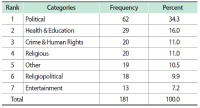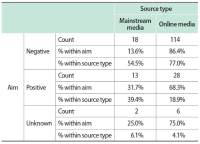ISSN : 2287-9099
Vol.8 No.3

Abstract
On information markets, we can identify different relations between sellers and their customers, with some users paying with money, some paying with attention, and others paying with their personal data. For the description of these different market relations, this article introduces the notion of arity into the scientific discussion. On unary information markets, customers pay with their money; examples include commercial information suppliers. Binary information markets are characterized by one market side paying with attention (e.g., on the search engine Google) or with personal data (e.g., on most social media services) and the other market side (mainly advertisers) paying with money. Our example of a ternary market is a social media market with the additional market side of influencers. If customers buy on unary markets, they know what to pay (in terms of money). If they pay with attention or with their personal data, they do not know what they have to pay exactly in the end. On n-ary markets (n greater than 1), laws should regulate company’s abuse of money and―which is new―abuse of data streams with the aid of competition (or anti-trust) laws, and by modified data protection laws, which are guided by fair use of end users’ attention and data.

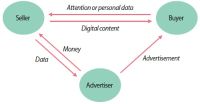
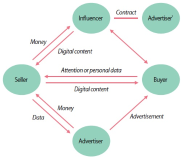
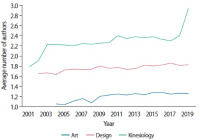
Abstract
This study aims to describe the general patterns of Korean research in Arts and Kinesiology, particularly from the perspective of authorship. Among the 12 sub-areas of Arts and Kinesiology indexed in the Korean Citation Index (KCI), journals in three sub-areas, “Arts,” “Design,” and “Kinesiology” have the longest publishing histories and produced the largest volume of articles. 68 journals in the “Arts,” “Design,” and “Kinesiology” sub-areas were accredited in the KCI between 2001 and 2019; 40,955 articles which were published in the journals between the years of accreditation and the end of 2019 serve as the context of this article. Authorship, affiliated institutions and countries, openness to new authors, top researchers, topological properties of authorship networks, overall research performance by authors, and co-authorship patterns were analyzed and compared among three sub-subjects.

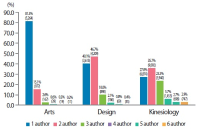

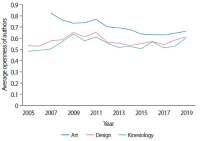



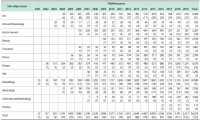



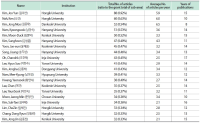
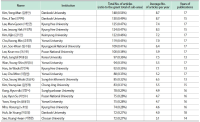




Abstract
This research aimed (1) to study and analyze the ability of current information retrieval (IR) systems based on views of information behavior (IB), and (2) to propose a conceptual framework for an IB model based on the collaboration between the system and user, with the intent of developing an IR system that can apply intelligent techniques to enhance system efficiency. The methods in this study consisted of (1) document analysis which included studying the characteristics and efficiencies of the current IR systems and studying the IB models in the digital environment, and (2) implementation of the Delphi technique through an in-depth interview method with experts. The research results were presented in three main parts. First, the IB model was categorized into eight stages, different from traditional IB, in the digital environment, which can correspond to all behaviors and be applied to with an IR system. Second, insufficient functions and log file storage hinder the system from effectively understanding and accommodating user behavior in the digital environment. Last, the proposed conceptual framework illustrated that there are stages that can add intelligent techniques to the IR system based on the collaboration perspective between the user and system to boost the users’ cognitive ability and make the IR system more user-friendly. Importantly, the conceptual framework for the IB model based on the collaboration perspective between the user and system for IR assisted the ability of information systems to learn, recognize, and comprehend human IB according to individual characteristics, leading to enhancement of interaction between the system and users.

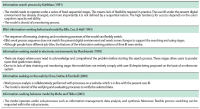

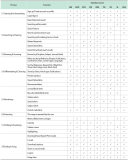



Abstract
This study focuses on users of activity tracking technologies and their related information behavior. How useful is the provided information by the trackers? Do users understand all information and explanations? We conducted a web-based survey. All in all, 631 users of a tracking device filled out the survey. From the perspective of information science, this investigation aims to analyze information needs considering different types of the provided information by activity tracking technologies. Are users satisfied by using the information on their steps, heart rates, and sleep duration? How do users assess readability about heart rate zones and sleep stages? Additionally, we investigated if users understand how to reflect on and adapt their health behavior based on the received explanations. According to the results, users mainly agree that the received information (raw data as well as – to a lesser extent – aggregated data in the form of corresponding diagrams) is useful, that the explanations are easy to understand, and that they know how to use this obtained information. This investigation enables an in-depth insight into how users are applying the self-quantifying activity and health information and which information needs are satisfied.






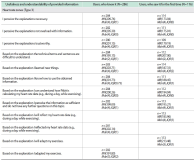


Abstract
Scientometrics and social network analysis (SNA) measures were used to analyze the international scientific collaboration (ISC) of All India Institute of Medical Sciences (AIIMS) for a period of 10 years (2009-2018). The dataset consists of 19,622 records retrieved from the Scopus database. The mean degree of collaboration 0.95 implied that researchers of AIIMS tend to collaborate domestically (80.29%) and internationally (14.67%). The data exhibits a hyper authorship pattern, and a medium-size research team consists of 4 to 10 authors who contributed a maximum of 62.08% (12,182) publications. 71.97% of research findings are scattered in journal articles. The most preferred journals published 58.55% of medical literature. An undirected collaboration network is constructed in Pajek to study the ISC of AIIMS during the period 2009-2018 which consists of 179 vertices (Vn) and 11,938 edges. The degree centrality (Dc) identified that the United States of America (Dc - 54; CC - 0.99) and United Kingdom (Dc - 41; 0.98) are the most collaborative countries in the whole network as well as the most influential countries. The Louvain community detection method is used to detect influential research groups of AIIMS. The temporal evolution of ISC of AIIMS studied through scientometrics and SNA measures shed light on the structure and properties of ISC networks of AIIMS. It revealed that AIIMS, India has taken keen steps to enrich the quality of research by extending and encouraging the collaboration between institutions and industries at the international level.




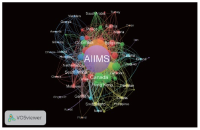

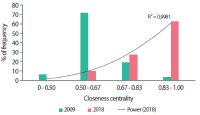

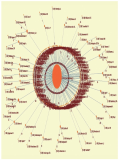
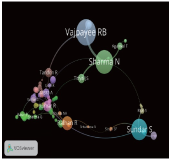

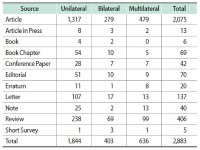

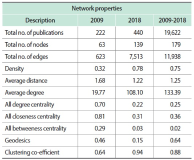




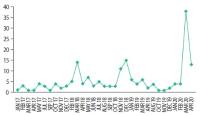
Abstract
This study analyzes N=181 social media rumors from Bangladesh to find out the most popular themes, sources, and aims. The result shows that social media rumors have seven popular themes: political, health & education, crime & human rights, religious, religiopolitical, entertainment, and other. Also, online media and mainstream media are the two main sources of social media rumors, along with three tentative aims: positive, negative, and unknown. A few major findings of this research are: Political rumors dominate social media, but its percentage is decreasing, while religion-related rumors are increasing; most of the social media rumors are negative and emerge from online media, and social media itself is the dominant online source of social media rumors; and, most of the health-related rumors are negative and surge during a crisis period, such as the COVID-19 pandemic. This paper identifies some of its limitations with the data collection period, data source, and data analysis. Providing a few research directions, this study also elucidates the contributions of its results in academia and policymaking.


